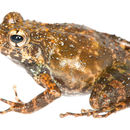Description
provided by AmphibiaWeb articles
M 33-34 mm, F 32-34 mm. Tibiotarsal articulation reaches between eye and nostril. Hand without webbing, foot webbing 1(1), 2i(2), 2e(1), 2i(2.5), 3e(2), 4i(3), 4e(3), (1.5). Dorsal skin granular. Colour dorsally brown with indistinct darker markings. Venter whitish, in some populations yellowish on the posterior belly and limbs, throat dark except for a light median stripe. Males with a blackish paired subgular vocal sac. Femoral glands distinct and large in some populations, rather indistinct in other populations.Taken with permission from Glaw and Vences (2007).
Andreone, F. and Raxworthy, C. (2008). Gephyromantis pseudoasper. In: IUCN 2008. 2008 IUCN Red List of Threatened Species. www.iucnredlist.org. Downloaded on 18 March 2009.
- author
- Miguel Vences
- author
- Frank Glaw
Distribution and Habitat
provided by AmphibiaWeb articles
Ankarana, Benavony, Berara forest, Lokobe, Manongarivo, Marojejy, Montagne d’ Ambre, Nosy Be, Nosy Komba, Tsaratanana (Andampy campsite).It has been recorded from sea level up to 900m (Andreone and Raxworthy 2008).
- author
- Miguel Vences
- author
- Frank Glaw
Life History, Abundance, Activity, and Special Behaviors
provided by AmphibiaWeb articles
Habits: Males call during day and night in primary forest. Most intensive calling has been heard in the very early morning during dawn. Calling specimens sit on the ground or in elevated positions on trees, and are not always aggregated around water. One female laid 12 large yellowish eggs. Tadpoles in streams.Calls: Typically a rapid series of three notes; several (about three) such note series emitted one after the other, followed by long intervals of silence. Very loud and difficult to locate.
- author
- Miguel Vences
- author
- Frank Glaw
Life History, Abundance, Activity, and Special Behaviors
provided by AmphibiaWeb articles
This species is listed as least concern since, although its Extent of Occurrence is probably less than 20,000 km2, it is common and adaptable with a presumed large population, and it is unlikely to be declining fast enough to qualify for listing in a more threatened category (Andreone and Raxworthy 2008).
- author
- Miguel Vences
- author
- Frank Glaw
Gephyromantis pseudoasper
provided by wikipedia EN
Gephyromantis pseudoasper, also known as the Massif Madagascar frog, is a species of frog in the family Mantellidae. It is endemic to northern Madagascar.[1][2] It occurs in both pristine and degraded rainforests and in secondary vegetation at elevations up to 900 m (3,000 ft) above sea level. It can be found both on the ground and in trees. Breeding takes place in streams.[1]
Advertisement call
The advertisement call of the species is an energetic, high-pitched series of notes, emitted often in the early hours of the morning.
The advertisement call of
Gephyromantis pseudoasper in Montagne d'Ambre recorded on 2017-12-09 at 04h15, with other specimens calling in the background
References

- license
- cc-by-sa-3.0
- copyright
- Wikipedia authors and editors
Gephyromantis pseudoasper: Brief Summary
provided by wikipedia EN
Gephyromantis pseudoasper, also known as the Massif Madagascar frog, is a species of frog in the family Mantellidae. It is endemic to northern Madagascar. It occurs in both pristine and degraded rainforests and in secondary vegetation at elevations up to 900 m (3,000 ft) above sea level. It can be found both on the ground and in trees. Breeding takes place in streams.
- license
- cc-by-sa-3.0
- copyright
- Wikipedia authors and editors

